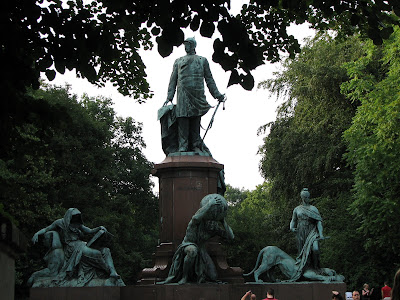 Berlin: the setting of immense upheaval and reform in the last century, home to giants such as Peter Behrens and Mies van der Rohe, the last stronghold of the movement that was the Bauhaus, a city bold in its embrace and expression of modernity, the very streets of which exude an understated but distinct elegance in their simplicity.
Berlin: the setting of immense upheaval and reform in the last century, home to giants such as Peter Behrens and Mies van der Rohe, the last stronghold of the movement that was the Bauhaus, a city bold in its embrace and expression of modernity, the very streets of which exude an understated but distinct elegance in their simplicity. Berlin might not be as “Beaux Arts” pretty as Paris, but there is bold and utilitarian experimentation in its architecture. It is not a city shaped by a tentative curator whose main concern is to preserve precious relics, but by craftsmen who are unafraid to design contemporary architecture in the spirit of the contemporary age.
On Friday, I took the night train to Berlin.
Adolf Loos would have highly approved of the Berlin street facades
 If I had spoken a single word of German, perhaps I would have felt even more at home there. At the end of three days, I had learnt only one word: Hauptbahnhof (meaning Central Station). The reasons for this ineptitude on my part tell something about Germany. First, most German people I encountered were extremely respectful and I did not at all feel estranged. Second, most German people I met spoke at least a little bit of English. My three-day trip went by in a flash and I simply did not get a chance to buy a dictionary and begin my first German lesson. And lastly, everything in Germany is extremely intuitive and organized.
If I had spoken a single word of German, perhaps I would have felt even more at home there. At the end of three days, I had learnt only one word: Hauptbahnhof (meaning Central Station). The reasons for this ineptitude on my part tell something about Germany. First, most German people I encountered were extremely respectful and I did not at all feel estranged. Second, most German people I met spoke at least a little bit of English. My three-day trip went by in a flash and I simply did not get a chance to buy a dictionary and begin my first German lesson. And lastly, everything in Germany is extremely intuitive and organized.
 The process of “getting to know” a city is fascinating. You start by walking around and getting a sense of its identity, or DNA. This identity may be discerned in the smallest of things, like sidewalks, trash cans, the shoes people wear, the street signs, etc. In the Berlin streets, for example, the grass is untrimmed. The layers of the building facades and the visual imagery, or graphic design, tell the story of the city’s past, convey its present spirit, and hint at its future.
The process of “getting to know” a city is fascinating. You start by walking around and getting a sense of its identity, or DNA. This identity may be discerned in the smallest of things, like sidewalks, trash cans, the shoes people wear, the street signs, etc. In the Berlin streets, for example, the grass is untrimmed. The layers of the building facades and the visual imagery, or graphic design, tell the story of the city’s past, convey its present spirit, and hint at its future.The night train to Berlin
The train stopped at Metz at what must have been 2am. It reminded me of my friend Stephanie who lives in Metz and who had invited me to visit her. I was sitting in the bar cart because I couldn’t bear the couchette anymore. It had been a shock to walk into the tiny compartment with six “beds,” three stacked on each side of a very narrow passage in which two people could barely fit. I had one of the lowest bunks and its ceiling was so low I couldn’t even sit up and read. So after a small conversation with the two American girls from Seattle and the German man above me (the last two were a French couple who went to sleep immediately – they must do this a lot), and after shifting restlessly in my bed for two hours, I left with my copy of Les Miserables to find food and a chair in which I could sit upright and read.
The blue sign glimmered in the night: Metz. People got out to smoke and breathe the Metz air.
To be continued (maybe).
The Altes Museum, designed by Karl Friedrich Schinkel in 1825






No comments:
Post a Comment